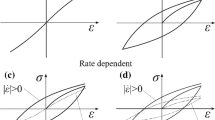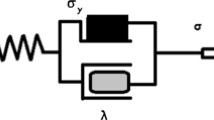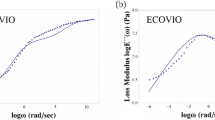Abstract
Fractional derivative and WLF equation are effective in describing the dynamic behavior and time-temperature effect of viscoelastic damping materials, respectively. These approaches have essentially evolved from the viscoelastic constitutive behavior. Based on such intrinsic relation, a fractional time-temperature superposition principle model (FTTSPM) that integrates the fractional constitutive relation and WLF equation was proposed. The parameters of this model were determined by performing tensile and DMA tests, and the master curves at 5 °C constructed by FTTSPM and WLF equation were compared. The theoretical prediction over the extended frequency span as the master curves was made by using the fractional standard linear solid model (FSLSM) to validate FTTSPM. The numerical results show that FTTSPM conforms to the time-temperature superposition principle. The parameters α and B′ in this model denote the impact of the material and environment on the shifted factor, respectively. For the storage and loss modulus, the extended frequency obtained by FTTSPM is broader than that obtained by the WLF equation. Moreover, the evaluation of the storage and loss modulus by FTTSPM is much closer to the theoretical prediction compared with that by the WLF equation. Therefore, FTTSPM is a concise and experiment-based approach with a higher precision and greater frequency-extended capacity compared with the WLF equation. However, FTTSPM inevitably faces a vertical shift when non-thermo-rheologically simple materials are considered. The physical mechanism and practical application of FTTSPM will be examined in further research.
Similar content being viewed by others
References
W. Y. Jung and A. J. Aref, A combined honeycomb and solid viscoelastic material for structural damping applications, Mechanics of Materials, 35 (8) (2003) 831–844.
C. H. Park, S. J. Ahn, H. C. Park and S. Na, Modeling of a hybrid passive damping system, Journal of Mechanical Science and Technology, 19 (1) (2005) 127–135.
R. K. Singh, R. Kant, S. S. Pandey, M. Asfer, B. Bhattacharya, P. k. panigrahi and S. Bhattacharya, Passive vibration damping using polymer pads with microchannel arrays, Journal of Microelectromechanical Systems, 22 (3) (2013) 695–707.
M. Mohammadimehr, A. A. Monajemi and M. Moradi, Vibration analysis of viscoelastic tapered micro-rod based onstrain gradient theory resting on visco-pasternak foundation using DQM, Journal of Mechanical Science and Technology, 29 (6) (2015) 2297–2305.
Z. L. Zhang, S. Q. Li, and W. G. Zhu, Temperature spectrum model of dynamic mechanical properties for viscoelastic damping materials, Journal of Mechanical Engineering, 47 (20) (2011) 135.
D. G. Fesko and N. W. Tschoegl, Time-temperature superposition in thermorheologically complex materials, Journal of Polymer Science Polymer Symposia, 35 (1) (2010) 51–69.
P. Micha, On the use of the WLF model in polymer and foods, Critical Reviews in Food Science and Nutrition, 32 (1) (1992) 59–66.
B. K. Ashokan and J. L. Kokini, Determination of the WLF constants of cooked soy flour and their dependence on the extent of cooking, Rheologica Acta, 45 (2) (2005) 192–201.
A. Mathias, K. Ulrich and F. Petra, Evaluation of the relevance of the glassy state as stability criterion for freeze-dried bacteria by application of the Arrhenius and WLF model, Cryobiology, 65 (3) (2012) 308–318.
P. Lima, S. Silva, J. Oliveira and V. Costa, Rheological properties of ground tyre rubber based thermoplasitc elastomeric blends, Polymer Testing, 45 (2015) 58–67.
J. R. Lin and L. W. Chen, The mechanical-viscoelastic model and WLF relationship in shape memorized linear ether-type polyurethanes, Journal of Polymer Research, 6 (1) (1999) 35–44.
J. Dudowicz, J. F. Douglas and K. F. Freed, The meaning of the “universal” WLF parameters of glass-forming polymer liquids, The Journal of Chemical Physics, 142 (1) (2015) 014905.
D. W. Schaffner, The application of the WLF equation to predict lag time as a function of temperature for three psychrotrophic bacteria, International Journal of Food Microbiology, 27 (2–3) (1995) 107–115.
J. L. Zheng, S T Lu and X. G. Tian, Viscoelastic damage characteristics of asphalt based on creep test, Engineering Mechanics, 25 (2008) 193–196.
F. Zhu, G. W. Xu and W. P. Ding, Tube theory based analysis on the rheological behavior of wheat gluten dough, Transactions of the Chinese Society of Agricultural Engineering, 23 (7) (2007) 24–29.
B. H. Liu, J. Zhou, Y. T. Sun, Y. Wang, J. Xu and Y. B. Li, An experimental study on the dynamic viscoelasticity of PVB film material for vehicle, Automotive Engineering, 34 (10) (2012) 898–904+927.
M. R. Permoon, J. Rashidinia, A. Parsa, H. Haddadpour and R. Salehi, Application of radial basis functions and sinc method for solving the forced vibration of fractional viscoelastic beam, Journal of Mechanical Science and Technology, 30 (7) (2016) 3001–3008.
Z. H. Tang, G. H. Luo, W. Chen and X. G. Yang, Dynamic characteristics of vibration system including rubber isolator, Journal of Nanjing University of Aeronautics & Astronautics, 46 (2) (2014) 285–291.
Z. L. Li, D. G. Sun, B. Sun, B. J. Yan, B. H. Han and J. Meng, Fractional model of viscoelastic oscillator and application to a crawler tractor, Noise Control Engineering Journal, 64 (3) (2016) 388–402.
K. X. Hu and K. Q. Zhu, A note on fractional Maxwell model for PMMA and PTFE, Polymer Testing, 30 (7) (2011) 797–799.
A. Hernández-Jiménez, J. Hernández-Santiago, A. Macias-García and J. Sánchez-González, Relaxation modulus in PMMA and PTFE fitting by fractional Maxwell model, Polymer Testing, 21 (3) (2002) 325–331.
A. W. Wharmby and R. L. Bagley, Modifying Maxwell’s equations for dielectric materials based on techniques from viscoelasticity and concepts from fractional calculus, International Journal of Engineering Science, 79 (2014) 59–80.
L. L. Cao, Y. Li, G. H. Tian, B. D. Liu and Y. Q. Chen, Time domain analysis of the fractional order weighted distributed parameter Maxwell model, Computers & Mathematics with Applications, 66 (5) (2013) 813–823.
J. S. Hwang and T. Y. Hsu, A fractional derivative model to include effect of ambient temperature on HDR bearings, Engineering Structures, 23 (5) (2001) 484–490.
S. Y. Zhu, C. B. Cai and P. D. Spanos, A nonlinear and fractional derivative viscoelastic model for rail pads in the dynamic analysis of coupled vehicle-slab track systems, Journal of Sound and Vibration, 335 (2015) 304–320.
F. Renaud, G. Chevallier, J. L. Dion and R. Lemaire, Viscoelasticity measurements and identification of viscoelastic parametric models, ASME 2011 International Design Engineering Technical Conferences and Computers and Information in Engineering Conference, Washington, DC, USA (2011) 701–708.
M. L. Williams, R. F. Landel and J. D. Ferry, The temperature dependence of relaxation mechanisms in amorphous polymers and other glass-forming liquids, Journal of the American Chemical Society, 77 (14) (1955) 3701–3707.
P. Jindal, R. N. Yadav and N. Kumar, Dynamic mechanical characterization of PC/MWCNT composites under variable temperature conditions, Iranian Polymer Journal, 26 (6) (2017) 445–452.
J. J. Espindola, M. S. Joao and M. O. Eduardo, A generalized fractional derivative approach to viscoelastic material properties measurement, Applied Mathematics and Computation, 164 (2) (2005) 493–506.
Author information
Authors and Affiliations
Corresponding author
Additional information
Recommended by Associate Editor Sungsoo Na
Li Zhanlong obtained his Ph.D. degree from Xi’an University of Technology and is currently serving as a lecturer at Taiyuan University of Science and Technology. His research interests include viscoelastic mechanics and its application in vibration and noise control.
Rights and permissions
About this article
Cite this article
Li, Z.L., Qin, Y., Sun, B. et al. A fractional approach to the time-temperature dependence of dynamic viscoelastic behavior. J Mech Sci Technol 33, 139–147 (2019). https://doi.org/10.1007/s12206-018-1214-5
Received:
Revised:
Accepted:
Published:
Issue Date:
DOI: https://doi.org/10.1007/s12206-018-1214-5




